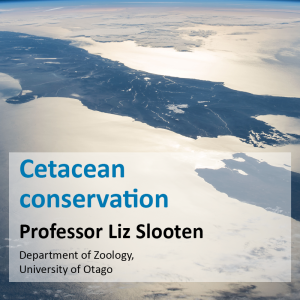Each day during the month of April, the Institute will feature one of the 30 ‘perspectives’ from the One Ocean report. These short articles include a diverse range of views regarding oceans management in New Zealand. Enjoy!
Today:
Professor Liz Slooten, Department of Zoology, University of Otago
Cetacean conservation
Nearly half of the world’s 80 whale and dolphin species are found in our waters. The top conservation priority is the endemic New Zealand dolphin (Cephalorhynchus hectori), which is declining due to mortality in fishing nets. The North Island subspecies, Māui’s dolphin, is worst off, with approximately 55 individuals remaining.
The solution is simple. Thirty years of research on New Zealand dolphins shows they do much better when fishermen don’t use gill-nets or trawl nets. For example, the Banks Peninsula population was declining six percent per year and is now almost stable (declining 0.1 percent per year). The bad news is that protected areas are still far too small. The Māui’s dolphin population is declining at nine percent per year. Several South Island populations are also still declining.
We are a long way from achieving the goals in the Department of Conservation Marine Mammal Action Plan for 2020–2020, which include ‘species recovery’ for New Zealand dolphin and ‘self-sustaining’ populations ‘within its natural range’. To make progress, we will need to set much more specific targets and timelines (e.g. to make fisheries mortality below 10 New Zealand dolphins per year by 2020).
Critical for achieving sustainability will be a rapid transition to dolphin-safe fishing methods and avoiding new activities that threaten marine environments, such as marine mining and tidal turbines.






















![20160906 McGuinness Institute - TacklingPovertyNZ Workshop – Far North Flyer [FINAL]](/wp-content/uploads/20160906-McGuinness-Institute-TacklingPovertyNZ-Workshop-%E2%80%93-Far-North-Flyer-FINAL-1-50x50.png)